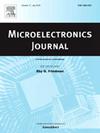A true random number generator based on autonomous Boolean network with imbalanced node oscillation rings
IF 1.9
3区 工程技术
Q3 ENGINEERING, ELECTRICAL & ELECTRONIC
引用次数: 0
Abstract
True random number generators have broad application prospects in the fields of hardware and information security. In order to improve the throughput of true random number generator with lower hardware overhead, an autonomous Boolean network with coupled basic logic units and imbalanced node oscillating rings is constructed as the entropy source. A first-order high-frequency oscillation loop is used to enhance the network refresh frequency, and a high entropy chaotic signal is generated through multi-level nonlinear coupling and amplification of the node output signals. Each output signal of the entropy circuit is sampled with D Flip-Flop and the result is sent to a post-processing circuit composed of XOR network, where the true random number is obtained. The proposed TRNG is implemented on Xilinx A7 FPGA development board. The sampled output data is grabbed and extracted in real time using the ChipScope IP module, and then transferred to computer for experimental testing. NIST SP800-22 and SP800-90B randomness tests are performed on the generated data, and some other important performances such as deviation, autocorrelation, and maximum Lyapunov exponent are also evaluated. The results show that at a throughput of 750Mbps, the proposed TRNG can generate true random numbers with entropy values of 0.996323bps, low deviation and low autocorrelation, being also of low hardware overhead.
基于不平衡节点振荡环自治布尔网络的真随机数生成器
真随机数发生器在硬件和信息安全领域具有广阔的应用前景。为了以较低的硬件开销提高真随机数生成器的吞吐量,构造了一个基本逻辑单元与不平衡节点振荡环耦合的自治布尔网络作为熵源。采用一阶高频振荡环提高网络刷新频率,对节点输出信号进行多级非线性耦合和放大,产生高熵混沌信号。熵电路的每个输出信号用D Flip-Flop进行采样,将采样结果送入由异或网络组成的后处理电路,在后处理电路中得到真正的随机数。所提出的TRNG在Xilinx A7 FPGA开发板上实现。通过ChipScope IP模块对采样后的输出数据进行实时抓取和提取,然后传输到计算机进行实验测试。对生成的数据进行了NIST SP800-22和SP800-90B随机性测试,并对偏差、自相关、最大Lyapunov指数等重要性能进行了评价。结果表明,在吞吐量为750Mbps的情况下,所提出的TRNG可以生成熵值为0.996323bps的真随机数,具有低偏差和低自相关性,硬件开销低。
本文章由计算机程序翻译,如有差异,请以英文原文为准。
求助全文
约1分钟内获得全文
求助全文
来源期刊

Microelectronics Journal
工程技术-工程:电子与电气
CiteScore
4.00
自引率
27.30%
发文量
222
审稿时长
43 days
期刊介绍:
Published since 1969, the Microelectronics Journal is an international forum for the dissemination of research and applications of microelectronic systems, circuits, and emerging technologies. Papers published in the Microelectronics Journal have undergone peer review to ensure originality, relevance, and timeliness. The journal thus provides a worldwide, regular, and comprehensive update on microelectronic circuits and systems.
The Microelectronics Journal invites papers describing significant research and applications in all of the areas listed below. Comprehensive review/survey papers covering recent developments will also be considered. The Microelectronics Journal covers circuits and systems. This topic includes but is not limited to: Analog, digital, mixed, and RF circuits and related design methodologies; Logic, architectural, and system level synthesis; Testing, design for testability, built-in self-test; Area, power, and thermal analysis and design; Mixed-domain simulation and design; Embedded systems; Non-von Neumann computing and related technologies and circuits; Design and test of high complexity systems integration; SoC, NoC, SIP, and NIP design and test; 3-D integration design and analysis; Emerging device technologies and circuits, such as FinFETs, SETs, spintronics, SFQ, MTJ, etc.
Application aspects such as signal and image processing including circuits for cryptography, sensors, and actuators including sensor networks, reliability and quality issues, and economic models are also welcome.
 求助内容:
求助内容: 应助结果提醒方式:
应助结果提醒方式:


